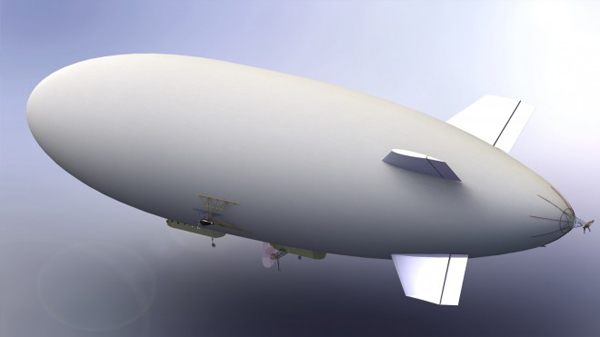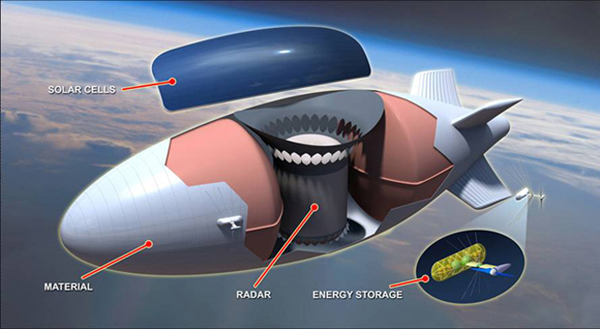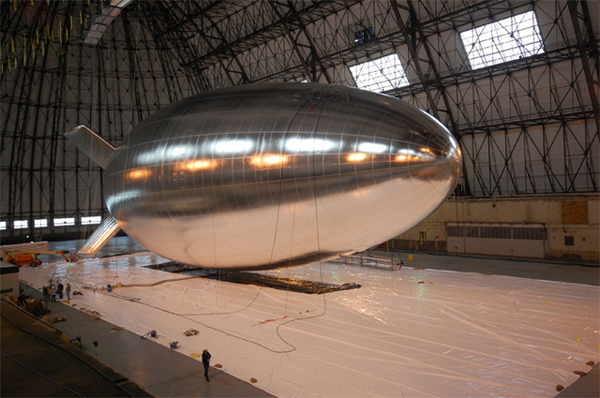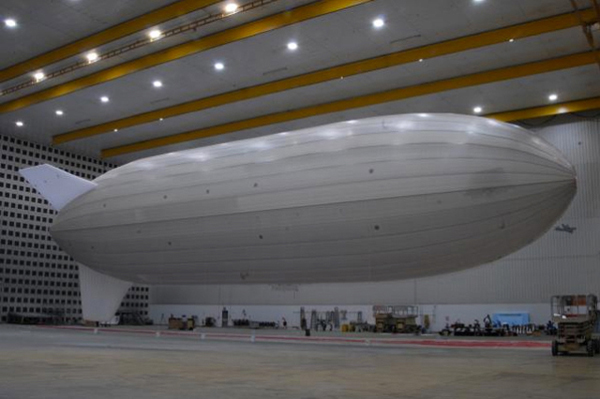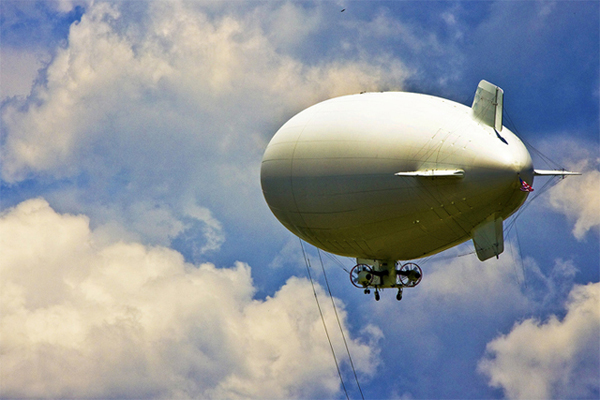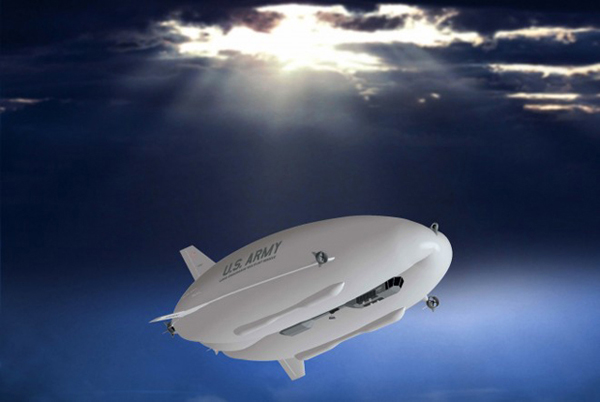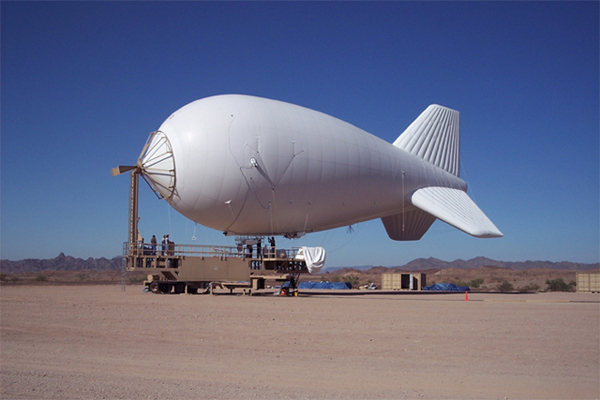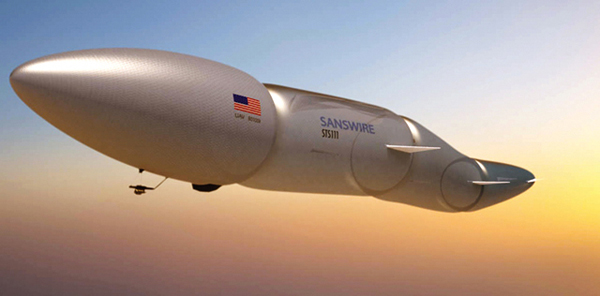In recent years, airships have once again become a major force in aviation. The Pentagon has gone especially blimp-crazy, pouring hundreds of millions of dollars into advanced — and massive — surveillance airships that can stay in the sky way longer than any unmanned aircraft. Here is a review of some of the new generation by Wired’s Danger Room:
This “freakishly large” airship would hover 20,000 feet above ground, using its on-board supercomputer to spy for miles around. The power comes from up to 12 different sensors, including an eavesdropping unit and nine tiny cameras that talk to each other while adjusting precisely where to look and listen. After collecting all that data, the Blue Devil has enough real estate on board to do much of the processing in the air – no human analyst required.
According to retired Lt. Gen. David Deptula, “it could change the nature of overhead surveillance.” For one, he estimates it’d be a lot cheaper, costing about $1,000 per hour (compared to the $8,000 of other airships).
The construction of this longer than a football field blimp is still underway, but it’s expected to be ready for the Air Force by January. Right now, the same surveillance gear that would be used on the airship is already in Afghanistan atop four Blue Devil planes.
ISIS
Darpa’s supersized ISIS (or Integrated Sensor is Structure) is a technology packed 450-foot long airship that would perch 70,000 feet in the air. The unmanned vehicle is designed to float at its Heaven’s eye view for up to 10 years, zipping along at up to 115 miles per hour to reach anywhere on the globe in 10 days.
The ISIS would be pretty impressive with just its surveillance and tracking capabilities – 187 miles for people on the ground and 373 miles for cruise missiles in the air. But what really distinguishes it from other monster blimps are its new technologies. Its array radar system could spot any movement on or above the battlefield – in high res. The hull, made of super lightweight material, would be much stronger than conventional materials and last 10 times as long. And the whole airship can also take care of itself via solar-regenerative power, absorbing sunlight by day and generating energy with fuel cells at night.
The airship will provide “unsurpassed situational awareness,” according to Darpa. ISIS is still in the design and simulation phase, but we’re hoping to see a small demonstration prototype by 2014.
HALE-D
Hovering above the jet stream, this autonomous high-flying airship would be able to survey millions of miles of airspace for months. The HALE-D is part of the U.S. Army’s Space and Missile Defense Command’s High Altitude Airship (HAA) program. Lockheed Martin claims that the airship technology enters “into a realm that gives users capabilities on par with satellites at a fraction of the cost.”
Unfortunately, its first test flight this week didn’t go so well. The airship encountered some technical difficulties at 32,000 feet, and crashed into the woods of New Freeport, Pennsylvania. Authorities are now trying to fetch the shrivelled Hale-D from the tree tops.
HiSentinel80
Launching into the sky like a weather balloon, the HiSentinel80 is just one of a family of autonomous, high-altitude, long-endurance airships being developed for the U.S. Army Space and Missile Defense Command/Army Forces Strategic Command.
It’s made of super thin translucent fabric which folds down to a small cube but inflates to 200 feet in the air. It runs on internal solar panels and can survey a 600-mile-wide radius. And since it’s perched 13 to 15 miles high, it’s safer from enemy attack or bad weather. The HiSentinel80 had its first successful flight test last November, and is now in the process of more testing for environmental effects and military utility.
This do-gooder airship patrolled New Orleans from above after the oil spill. The Navy sent the 178-foot blimp (which uses less fuel than a helicopter or plane) to help clean up, direct large skimming ships to patches of oil, and search for trapped turtles, dolphins, birds and whales
Long Endurance Multi-Intelligence (LEMV) Airship
The Long Endurance Multi-Intelligence (LEMV) airship has been likened to an “unblinking eye,” soaring for weeks at a time and aiming its bundle of infra-red sensors and signal intelligence system at anything below. What makes the LEMV so special (besides its “more than 21 days of unblinking stare”) is a hybrid propulsion system, which combines helium and an aerodynamic design that gives it airplane-like lift.
The defence contracting corporation Northrop Grumman got a $517 million contract last year to build three of the monster spy blimps for the military. The Army plans to deploy them to Afghanistan, but we won’t see the first LEMV until at least January, if not later.
Persistent Threat Detection System (PTDS)
While some blimps fly freely, others are anchored to ground. The tethered Persistent Threat Detection System (PTDS) is supposed to provide long-endurance intelligence, surveillance, reconnaissance and communications at a low cost.
The U.S. Army has been using these around-the-clock systems in Afghanistan and Iraq since 2004 – they’re up to at least 37. That number is increasing. This past April the Pentagon announced pouring up to $1 billion more for intelligence, surveillance and reconnaissance gear in Afghanistan, mostly in the form of balloon mounted cameras and aerostats. A cheaper alternative to drones, the tethered blimps may also deter insurgents from planting make-shift bombs, a rising problem in Afghanistan.
“When daisy chained together throughout a battlespace it soaks up the terrain and becomes eyes in the sky,” says Pentagon press secretary Geoff Morrell.
Sanswire-TAO STS-111
This unusually shaped blimp (111-foot long, 11-foot tall) is designed to wiggle through the wind more easily than a clunky round airship, thanks to its multi-segmented body. The flying silver worm is propelled by helium in the first segment, and can deliver its payload via an air drop system that separates from the airship.
We haven’t seen much new activity around the STS-111 since it its first test-flight in 2009, but Sanswire has several other elongated airships in the making, including the Argus One, the SkySat and the Stratellite.
Pelican
The Aeroscraft, touting ship-like payloads and helicopter-like operations, is designed to be a blimp that acts like a U-Haul. Need to transport 500 tons of troops and cargo? Sure. No airstrip? No problem. The Pelican would be able to land anywhere on land or water, its army unit ready to fight within six hours. This “tri-phibian” (air, land, sea) project was based on Darpa’s Walrus programme, which was cancelled in 2006. But the aviation technology company Aeros is determined to keep hope alive with Pelican. A (relatively) small prototype, supposed to carry a mere 60 tons, is due to fly sometime by the end of 2013.
Source: Wired Danger Room

